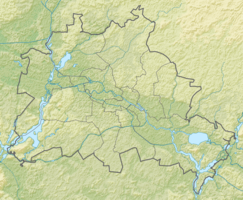Volkspark Wuhlheide
| Volkspark Wuhlheide from 1950 to 1990: "Ernst Thälmann" pioneer park |
||
|---|---|---|
| Park in Berlin | ||

|
||
| Eichgestell, main path of the Wuhlheide public park | ||
| Basic data | ||
| place | Berlin | |
| District | Oberschöneweide | |
| Created | 1924-1932 | |
| Newly designed | around 1994 (partially) | |
| Surrounding streets |
Treskowallee , An der Wuhlheide |
|
| use | ||
| User groups | Foot traffic ; Leisure , events | |
| Park design | Ernst Harrich | |
| Technical specifications | ||
| Parking area | approx. 79 ha (FEZ approx. 117 ha) |
|
|
52 ° 28 '0 " N , 13 ° 31' 35" E
|
||
The Volkspark Wuhlheide is a park in Berlin's Wuhlheide , a forest area in the Oberschöneweide district . Since it was built in the 1920s until today, it has often been rebuilt or converted, sometimes only parts of the large area.
history
1924-1945
The Volkspark Wuhlheide was built between 1924 and 1932 according to plans by the then Treptower gardening director Ernst Harrich . With the establishment of the Wuhlheide people's and forest park , the connection between forest and park was intended to take into account the most varied of wishes and demands on the use of the urban forest area. The horticultural concept envisaged landscaped rest areas with varied forest images for quiet relaxation as well as areas for active relaxation. In addition to sports and play fields, children's play areas and sports fields, a dance floor, a paddling pool , a toboggan slope and an outdoor pool (light and air bath) were also built. Buildings and terraces made of natural stone and rose trellises made the park a popular meeting place for the residents of the nearby districts of Oberschöneweide and Karlshorst . With the amalgamation of intensively used park and near-natural forest, the forest park idea that emerged as part of the “People's Park Movement” of the 1920s was realized. The Volkspark Wuhlheide was one of the three largest forest parks that were created during this time.
With the Second World War , the park began to decline. A barrack camp for forced laborers was initially built on the site . The construction of flak positions, a smaller air raid shelter on the street An der Wuhlheide and the associated acts of war led to the destruction of many park areas and buildings.
1945–1990
After 1945, large areas of the park - including the forced labor camp - were confiscated as a military camp of the Soviet city command and later expanded into barracks for the Soviet armed forces group in Germany .
After the war, the devastated parks were not reforested and the horticultural facilities were no longer maintained. Only the light and air bath was still used and the sports practice area was redesigned to become the Ernst Thälmann Stadium . So the western part of the Wuhlheide lost its park character and became forested. The East Berlin administration focused on the eastern side of Wuhlheide and built here in 1950 by the chairman of the KPD Ernst Thalmann named Pioneer Park Ernst Thalmann , who to this day as leisure and recreation center (FEZ) is used for children and adolescents. In 1979 the "Ernst Thälmann" pioneer palace was opened.
Since 1990
At the end of the 1990s, plans began for a gradual reconstruction of the Volkspark. As part of job creation measures , foundations and boundaries of former facilities were exposed and bushes were removed from former meadows and playgrounds. The outdoor swimming pool was extensively renovated in the style of the 1920s and the former military areas were renatured. The Volkspark Wuhlheide is included in the Berlin State Monument List.
Model park Berlin-Brandenburg
In the spring of 2007, the Berlin-Brandenburg model park opened on the site of the former Ernst Thälmann Stadium . Embedded in a landscape park that recreates the characteristics of the region, visitors can see more than 60 models of well-known Berlin and Brandenburg sights - faithfully made on a scale of 1:25 . The model park is constantly being expanded with new miniatures. The stadium was partially demolished for this, and the local sports club had to move.
literature
- Berlin and its buildings, part XI, gardening. DOM Publishers, Berlin 1972, pp. 94-95, ISBN 978-3-433-00587-3 .
- Gottfried Funeck, Waltraud Schönholz, Fritz Steinwasser: Park and green areas in Berlin . Berlin-Information 1987, ISBN 3-7442-0028-0 .
- Marina Goertz: Green oases in Berlin, leisure and relaxation in parks and gardens. Nicolaische Verlagsbuchhandlung, Berlin 1999. ISBN 3-87584-764-4 .
- Jörg Bock: the wuhlheide. Kulturring in Berlin eV, Berlin 2013, ISBN 978-3-9814590-6-7 .
Web links
- Official website of the Volkspark Wuhlheide
- The Volkspark Wuhlheide on berlin.de
- Entry in the Berlin State Monument List: Volkspark Wuhlheide
- Official website of the FEZ
- Program and official website of the Kindl-Bühne Wuhlheide
- Official website of the Berlin-Brandenburg model park
- Official website of the Wuhlheide Park Railway
- ProWuhlheide e. V. - Association of actors of the Wuhlheide

